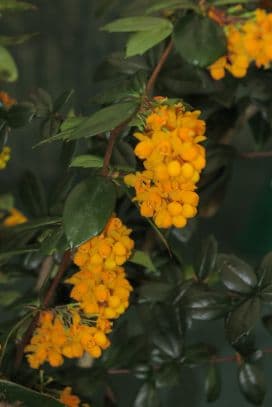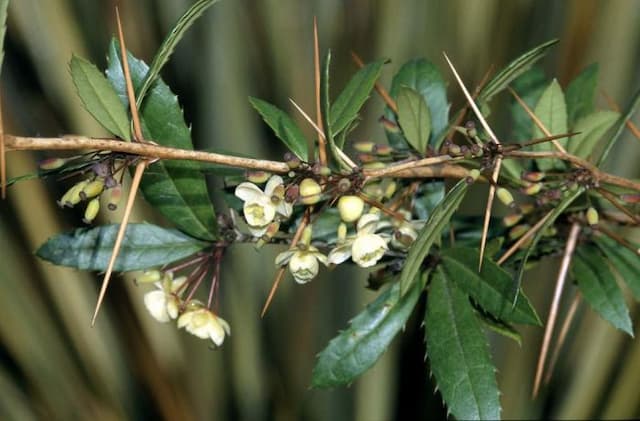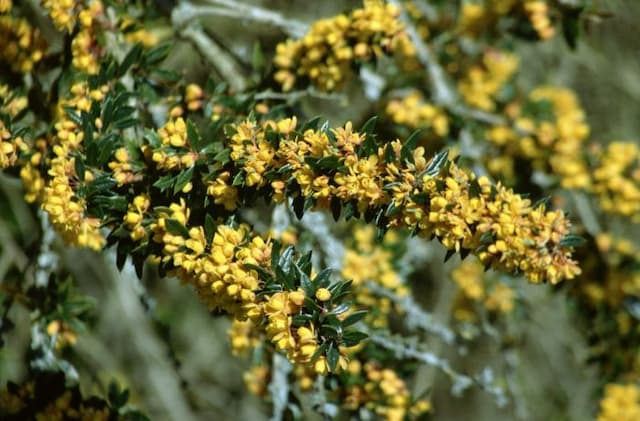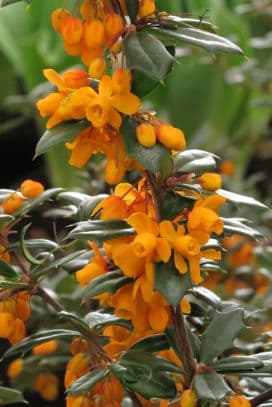Blue Cohosh Caulophyllum thalictroides

ABOUT
The common name for Caulophyllum thalictroides is blue cohosh. This plant boasts a distinct appearance, with compound leaves that are finely divided and resemble those of meadow rue. The leaves are multiple-lobed and have a bluish-green tinge, contributing to the common name. During the flowering season, the blue cohosh bears small, yellow-green flowers that lack petals but have conspicuous sepals. These flowers are not particularly showy and tend to blend in with the foliage. As the growing season progresses, the plant produces blueberry-like seeds which are strikingly blue and offer a strong visual interest. These seeds stand out against the foliage and can persist into the early winter, adding to the plant's character in the garden. Its stems typically have a purplish or reddish hue that further accentuates the blue-green leaves, giving the blue cohosh a unique and attractive appearance that sets it apart from other woodland plants.
About this plant
 Names
NamesFamily
Berberidaceae
Synonyms
Blue Cohosh, Blueberry Root, Squaw Root, Papoose Root, Yellow Ginseng, Beechdrops
Common names
Caulophyllum giganteum, Leontice thalictroides, Caulophyllum thalictroides var. giganteum.
 Toxicity
ToxicityTo humans
The common name for Caulophyllum thalictroides is blue cohosh. Blue cohosh contains several compounds that can be toxic to humans if ingested, such as alkaloids and saponins. The plant's roots and berries are considered the most toxic parts. Symptoms of blue cohosh poisoning may include nausea, vomiting, diarrhea, stomach cramps, and in severe cases, respiratory failure, seizures, or myocardial toxicity. Pregnant women should particularly avoid blue cohosh as it can stimulate uterine contractions and lead to miscarriage or premature labor.
To pets
The blue cohosh is similarly toxic to pets as it is to humans. If pets ingest any part of the plant, especially the roots or berries, they could experience symptoms like vomiting, diarrhea, abdominal pain, muscle weakness, and potential heart problems. Severe poisoning could lead to more serious conditions such as organ failure or even death. Pet owners should prevent their animals from having access to blue cohosh and seek veterinary care immediately if they suspect their pet has ingested it.
 Characteristics
CharacteristicsLife cycle
Perennials
Foliage type
Deciduous
Color of leaves
Green
Flower color
Yellow-green
Height
2-3 feet (0.6-0.9 meters)
Spread
2-3 feet (0.6-0.9 meters)
Plant type
Herb
Hardiness zones
3-8
Native area
North America
Benefits
 General Benefits
General Benefits- Wildlife Habitat: Caulophyllum thalictroides, commonly known as blue cohosh, provides shelter and habitat for various insects and animals in its native woodland environment.
- Erosion Control: The plant helps stabilize soil in forested areas, thereby contributing to the prevention of erosion.
- Ornamental Value: Blue cohosh has distinctive blue berries and deeply dissected foliage that can add visual interest to shade gardens.
- Traditional Use: It has historical significance in native cultures as a part of traditional rituals and ceremonies.
- Forest Diversity: Blue cohosh contributes to the biodiversity of hardwood forests, playing a role in the ecological balance of these environments.
- Seasonal Interest: With its springtime flowers and fall fruit, the plant provides changing visual interest throughout the seasons.
- Food Source: The berries of blue cohosh may serve as food for certain bird species, integrating it into the local food web.
- Naturalization: This native plant species supports efforts in natural landscaping and restoration projects aimed at creating sustainable plant communities.
 Medical Properties
Medical Properties- Parturition aid: Blue cohosh has been traditionally used by Native Americans to help facilitate childbirth.
- Menstrual disorders: It has been used to regulate menstrual flow and alleviate menstrual cramps.
- Antispasmodic: It possesses antispasmodic properties that may help in relieving muscle spasms and cramps.
- Diuretic: Blue cohosh has diuretic effects that could promote the expulsion of urine, potentially helping with water retention.
- Anti-inflammatory: There is some historical reference to its use in reducing inflammation although scientific substantiation is limited.
 Air-purifying Qualities
Air-purifying QualitiesThis plant is not specifically known for air purifying qualities.
 Other Uses
Other Uses- Dye Source: Caulophyllum thalictroides, commonly known as blue cohosh, can be used to produce a natural dye, with different parts yielding various shades.
- Garden Ornamental: Due to its distinctive blue-green foliage and small yellowish-green flowers, blue cohosh is sometimes planted for ornamental purposes in shade gardens.
- Insect Repellent: Some gardeners use blue cohosh in companion planting to repel certain insects, though its effectiveness is anecdotal.
- Soil Stabilization: Blue cohosh's robust root system can help stabilize soil and prevent erosion in forested areas.
- Indicator Species: Blue cohosh can serve as an indicator of a rich, mature hardwood forest, which can help in conservation efforts and forest management.
- Cultural Symbolism: Among some Native American tribes, blue cohosh carries cultural significance and is used in various traditional ceremonies.
- Educational Tool: In botanical and ecological studies, blue cohosh is used to illustrate plant life in deciduous forest ecosystems.
- Craft Materials: The dried berries and seeds of blue cohosh can be used in making crafts, such as jewelry or ornamental pieces.
- Photographic Subject: The plant's unique appearance makes it a popular subject for nature photographers and plant illustrators.
- Wildlife Food Source: While not a primary food source, the berries of blue cohosh may be eaten by certain bird species and small mammals.
Interesting Facts
 Feng Shui
Feng ShuiBlue cohosh is not used in Feng Shui practice.
 Zodiac Sign Compitability
Zodiac Sign CompitabilityBlue cohosh is not used in astrology practice.
 Plant Symbolism
Plant Symbolism- Femininity: Caulophyllum thalictroides, commonly known as Blue Cohosh, is often associated with femininity due to its historical use in supporting women's health issues, particularly during childbirth.
- Strength: Reflective of its reputation for aiding in the endurance required during childbirth, Blue Cohosh symbolizes inner strength and the ability to overcome physical challenges.
- Protection: This plant is symbolically linked to protection, as it has been used traditionally to ward off negative influences and protect against various ailments, particularly in the realms of pregnancy and labor.
- Transformation: Blue Cohosh represents transformation and new beginnings, echoing the transitions women experience in motherhood and the cycles of nature.
 Water
WaterBlue cohosh should be watered deeply but infrequently to mimic its natural woodland environment. Ideally, the soil should be kept consistently moist but not waterlogged. During the growing season, watering once a week with approximately one gallon of water should suffice, but this can vary depending on climate and weather conditions. In periods of drought or extreme heat, increase the frequency of watering to prevent the soil from drying out completely. In winter, reduce the amount of water as the plant enters dormancy and requires less moisture.
 Light
LightBlue cohosh prefers dappled sunlight or partial shade, akin to the conditions it would experience on the forest floor. It thrives best when protected from the intense midday sun, so a spot with morning sunlight or filtered light throughout the day is ideal. Full shade may be tolerated but can lead to less vigorous growth.
 Temperature
TemperatureBlue cohosh grows well in a temperature range typical of its native woodland habitats. It can survive minimum temperatures as low as 20°F but prefers a range between 50°F and 75°F. Prolonged exposure to temperatures above 80°F can cause stress to the plant. The ideal temperature range supports its growth phases from the emergence of foliage through to the development of its distinct blue berries.
 Pruning
PruningBlue cohosh typically does not require extensive pruning. Dead or damaged foliage can be removed to keep the plant healthy and prevent diseases. Pruning is best done in late fall or early spring before new growth starts. It's rarely necessary to shape the plant, as it naturally forms an attractive shape.
 Cleaning
CleaningAs needed
 Soil
SoilBlue cohosh thrives in a soil mix that is rich, moist, and well-draining, with a pH ranging from 5.5 to 6.5. The best soil mix can be achieved by blending loamy soil, leaf mold or compost, and sand to ensure proper aeration and moisture retention.
 Repotting
RepottingBlue cohosh, being a perennial, doesn't require frequent repotting. It can typically be repotted every 2-3 years, or when the root system outgrows the container, to refresh the soil and provide room for growth.
 Humidity & Misting
Humidity & MistingBlue cohosh prefers a moderately high humidity environment similar to its native understory habitat in the forest. A good range to aim for would be between 50% to 70% relative humidity for optimal growth.
 Suitable locations
Suitable locationsIndoor
Place blue cohosh in shaded area and keep soil moist.
Outdoor
Plant blue cohosh in shade, keep soil moist, protect from wind.
Hardiness zone
Blue cohosh is suitable for USDA zones 3-8.
 Life cycle
Life cycleBlue cohosh (Caulophyllum thalictroides) begins its life cycle as a seed, which upon germination in early spring, develops into a seedling with a single leaf. As it matures, the plant forms a compound, bluish-green leaf structure and a robust underground rhizome. Around maturity, which can take several years, the blue cohosh produces distinctive yellowish-green to purplish flowers, often before the foliage fully unfurls. Following pollination, often by small flies or beetles, these flowers give way to berries that start out green and ripen to a deep blue or blackish color. The seeds within the berries are then dispersed, often by birds or small mammals, to initiate a new cycle. During winter, the plant dies back to the rhizome, which remains dormant until the next spring when the cycle starts anew.
 Propogation
PropogationPropogation time
Spring to early summer
Blue cohosh, scientifically known as Caulophyllum thalictroides, is commonly propagated by seed. The best time to sow blue cohosh seeds is in the fall, directly after the berries ripen and the seeds are fresh. The seeds have a double dormancy requirement, meaning they need two cold periods separated by a warm period to germinate successfully, which often makes propagation by seed a slow process. The fresh seeds are sown shallowly, about 1/2 inch deep, in a moist, well-draining seedbed or directly in their desired location in the garden. Due to the complex dormancy, it may take up to 18 months for germination to occur. Meanwhile, the seeds must be kept moist and protected from predation. Since this natural cycle involves considerable time, patience is crucial when propagating blue cohosh via seeds.







![Japanese barberry [Bonanza Gold]](/_next/image?url=https%3A%2F%2Fplants-admin.emdemapps.com%2Fimages%2Fplants%2F%2Fimages%2F604b5385e413f.png&w=640&q=75)

